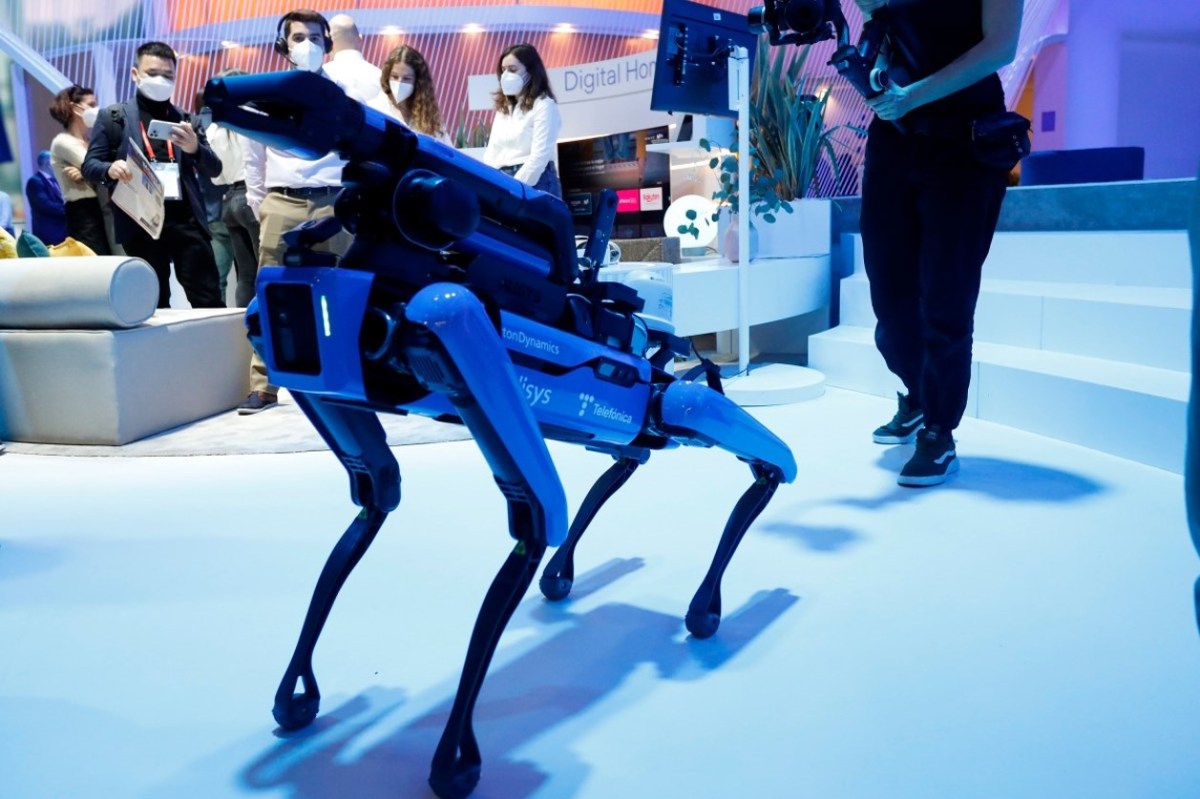Spot the dog
Mark Raibert, one of the most influential figures in robotics today, co-founded Boston Dynamics in 1992.
Among his other creations is Spot the dog, an intelligent robot that went on sale in the United States in 2020 for a price of 74,500 dollars. The brain of this canine is made up of AI algorithms that allow it to work autonomously, detecting and even predicting problems.
For industrial use, Spot provides information about routine operations or potential hazards in factories, research labs or construction sites.
At MWC 2022, Spot visited Telefónica’s stand to showcase its skills in developing technologies such as 5G and Edge Computing.
ASIMO
Introduced in 2000 by the Japanese company Honda, ASIMO is the acronym for Advanced Step in Innovative Mobility.
This humanoid robot has physical capabilities marked by autonomous movement that allow it to walk, run or even jump. It also controls its fingers independently and can perform tasks with precision.
Moreover, it is able to recognise voices or faces even if several people are talking at the same time.
Although ASIMO was born at the turn of the millennium, the Japanese company had been developing a walking robot since 1986. Over the next 14 years, and with different improvements, the prototype evolved in different versions until 1993, when the E6 arrived, prior to the P1, P2 and P3, which between 1993 and 1997 incorporated arms and legs.
A series of devices that were the prelude to ASIMO, a robot that has also had updated versions since its launch a quarter of a century ago.
Atlas
This six-foot-tall biped is a humanoid robot also created by Boston Dynamics that was launched in 2013.
Under the funding and supervision of the US Defense Advanced Research Projects Agency (DARPA), Atlas is designed for search and rescue missions.
According to information on Boston Dynamics’ own website, the robot is intended for real-world applications and features “an advanced control system and state-of-the-art hardware that give the robot the power and balance needed to demonstrate advanced agility and athleticism”.
The company also explains that its use is intended to ‘explore the potential of the humanoid form factor, harnessing the robot’s entire body to move with grace, speed and dexterity’, demonstrating that the next generation of robots will be marked by ‘the mobility, perception and intelligence needed to be commonplace in our lives’.
Ameca
This robotic android was born in 2021 and is designed as a platform for the development of future robotic technologies, as well as to facilitate robot-human interaction.
Ameca does not have the ability to walk, but its physical appearance – a kind of rubber skin on its hands and face – gives it a more human-like form than other robots.
Through the use of cameras (in its eyes and chest), microphones and facial recognition software, it can interact with the public.
Both its facial expressions and its interaction with attendees attracted attention at CES 2022 in Las Vegas, one of the most renowned and visited technology fairs in the world.
Through Chat GPT’s language models, Ameca is able to communicate naturally and with human facial expressiveness in different languages.
For these reasons, the company that develops it, Engineered Arts, defines it as ‘the world’s most advanced human-shaped robot and represents the cutting edge of human robotics technology’.
Pepper
At 1.20 metres tall and weighing 25kg, Pepper was born in 2014 by Softbank Robotics and was ‘designed for people’ with a business focus on greeting customers at the entrance of shops by engaging them in conversation and making recommendations.
The robot’s ability to provide general or product information in more than a dozen languages is focused, according to its creators, on sectors such as education, retail, banking and healthcare.
Communication with words, as well as eye movements and body language, give those who interact with it the sensation that they are interacting with a person, even picking up the comments that users have about the brand itself or the products or services offered.
RoboSapiens
Born in 2004 and created by Mark Tilden, this robot has sold almost two million units.
With almost seventy pre-programmed functions and more than 80 steps for programming movements, this human-shaped robotic toy is able to walk and grasp objects with its hand and subsequently even throw them.
Since its successful launch more than two decades ago, numerous subsequent versions (Mini RoboSapien, RoboSapien Jr., RoboSapien X or RoboSapien Blue) have been released with a purely recreational focus, unlike the other robots we started with at the beginning of the article.
